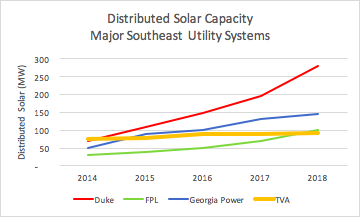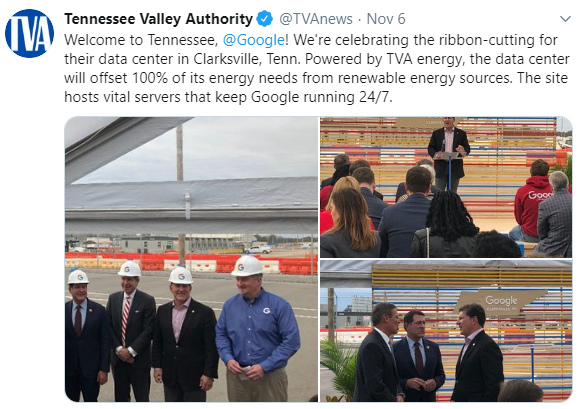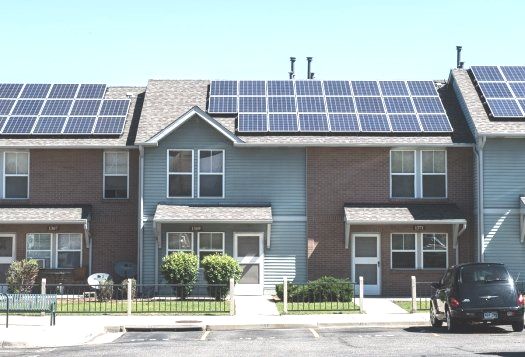On November 8, SACE submitted comments to TVA on their proposal to do away with a program that compensates customers for solar generated at their house or business and replace it with a list of approved contractors.
Maggie Shober and Bryan Jacob | November 12, 2019 | Alabama, Solar, Tennessee, UtilitiesThe Tennessee Valley Authority (TVA) is fundamentally failing to embrace renewable energy as a strategic priority. As with TVA’s recent pro-gas future resource plan and anti-solar rate changes, TVA continues to mislead customers. Additionally, the Draft 2019 Changes to Green Power Providers (GPP) Environmental Assessment (EA) further illustrate that TVA has become increasingly hostile to solar in the Tennessee Valley.
The Southern Alliance for Clean Energy (SACE) submitted comments to TVA on November 8 along with nearly 200 TVA customers including Tennessee residents, small business owners, etc. Here is what we collectively call on TVA to do:
- Continue to offer GPP with the current terms through the end of 2020.
- Perform an updated and comprehensive Value of Solar study.
- Engage stakeholders in a genuine, transparent process to develop a suitable alternative to the GPP program that fairly compensates customers for providing benefits to all TVA customers.
No time to read our full comments? We’ve summarized them below to make it easy for you to follow the issue.
What is the Green Power Providers (GPP) program?
Beginning in 2007, the GPP program established TVA as an early leader on distributed solar in the Southeast, offering “businesses and homeowners a chance to be a part of TVA’s work in generating clean, renewable energy for the people and communities of our region. [Customers] agree to install a small-scale renewable energy system on [their] property and TVA pays [that customer] for every kilowatt-hour generated by that system.” However, TVA has made changes since the program’s beginning and now TVA lags behind other major Southeast utilities on distributed solar, as seen in the chart below. Effective at the end of 2019, the GPP program will be closed to new applications but will maintain existing contracts until they expire. The end of the GPP program without a robust replacement means TVA customers lose the ability to choose to install their own generation and be fairly compensated for providing services to other customers.

TVA increasingly hostile to solar in the Tennessee Valley
The only significant solar in TVA’s pipeline for the next five years is exclusively to satisfy the demand of large corporate customers (e.g., projects like those for Facebook and Google). While cutting deals for large corporations and blocking the sun from smaller customers, TVA’s long-term resource plan approved by the TVA Board earlier this year misled the public about how much solar TVA actually intends to include on its system. Contrary to the headlines, TVA is not on track to install significant amounts of solar, distributed or otherwise, anytime soon.

TVA’s own program design drives under-utilization
In its proposal, TVA attempts to justify eliminating the GPP because it claims the program is underutilized. As a self-regulated monopoly, TVA has exclusive authority to design the program. If it’s no longer attractive, that’s because TVA made it so.
The proposal TVA put out shows a clear correlation between the number of residents that install solar and the amount those residents are paid for their generation. As TVA has decreased that amount, the number of residents installing solar has dropped. In fact, program participation increased in 2019 as TVA held the generation credit steady from 2018 through 2019. This indicates TVA customers want to install solar, and want a steady program that compensates them fairly for solar they generate, which is contrary to TVA’s claims.
Additionally, in its own market study, TVA found that a majority of households surveyed either had not heard of the GPP or did not know much about it. If TVA were to keep the GPP as it currently stands and market the program, it would likely see an uptick in residential solar installations.
TVA continues bogus claims of cost-shifting
TVA claims here and elsewhere that customer-installed solar shifts utility costs onto customers without solar. This claim has been disproved in numerous studies, some of which we detail in our comments. TVA should stop making such unsupported claims and stick to the facts.

Distributed solar is a vital companion to large-scale solar
TVA’s proposal presents a false choice between large-scale solar and the distributed solar that customers install on homes and businesses. The two serve different purposes and provide different benefits to customers. Riding a bus typically costs less than driving a car. Would TVA oppose car ownership?
Both distributed solar and large-scale solar offer energy (MWh) and capacity (MW) value to the system – and both provide environmental benefits by offsetting conventional generation resources, like fossil. Distributed solar, however, delivers additional aspects of value. Notable among those are: reduced line losses, avoided or reduced transmission and distribution capital investment, and added resiliency. These values reduce utility costs and thus lead to lower rates for all customers. If installed with storage and so that the system can separate safely from the grid, distributed solar also provides backup power to the home or business where it is installed in the case of a power outage. TVA attempted a study to quantify the benefits distributed solar in 2015, though this study left out key values such as health and monetary benefits of replacing fossil generation with non-emitting solar.
A combination or distributed solar and large-scale solar installation is necessary if TVA wants to further reduce its carbon emissions which are on track to only reduce 6% in the next 20 years.
TVA should improve, not replace, the GPP
When you install solar at your home or business you are connecting it to the distribution grid of your local utility, not directly to the large transmission lines run by TVA. The physics of electricity suggests that generation from GPP solar stays within the local utility’s network and does not make it out to TVA transmission lines. Consequently, there is no apparent reason that TVA should necessarily be involved in the transactions. Though, TVA claims the TVA Act prohibits your local utility from compensating solar customers for the benefits they provide to all local customers. If local utilities have the authority to implement their own energy-efficiency programs, then the same should apply for distributed solar.
TVA’s own survey found the GPP program to be more popular than the proposed replacement option, therefore TVA should be expanding and improving the GPP program instead of eliminating it. Improvements should include: expand access to low-income households, renters, and people living in multi-family homes; add the program features discussed in the GPP Replacement EA like a quality contractor network; and make the process to sign up more streamlined and consistent across the Tennessee Valley.
Local utilities should be empowered to design solar programs that meet the needs of their local business and residential customers. Any generation local utilities require from the TVA transmission system would still be exclusively from TVA and conform to the restrictive, all-requirements contracts between the local utilities and TVA.
The alternatives TVA considered to replace the GPP are entirely insufficient. Customers deserve a solar program that compensates them equitably for the power they generate and supply to their local utility. TVA should withdraw the changes to GPP and go back to the drawing board. To aid in quickly stabilizing the global climate, both large-scale and distributed, customer-owned solar are needed to decarbonize TVA’s electric grid as fast as possible. TVA can do better to maintain grid resiliency, and protect the people and places it serves across the Southeast.